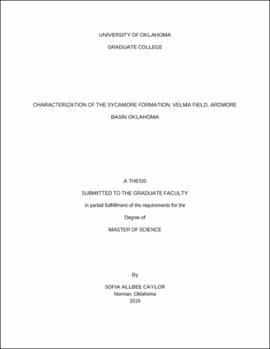| dc.description.abstract | The Velma field is located in the northwestern extent of the Ardmore Basin in southern Oklahoma. Historically the combined Sholem- Velma- Tatums field area is one of the top producing oil and gas conventional producing fields in Oklahoma. The area has been exploited for conventional and Woodford Shale unconventional reservoir targets formerly. Attention is now being turned to potential unconventional Mississippian reservoir units, such as the Sycamore Formation. The Sycamore Formation was cored in the X-1 well by the Getty Oil Company in 1980. Unfortunately, the well was dry as a conventional reservoir target but fortunately a core was taken and observed during this study to consider the Sycamore in this area as an unconventional target.
The internal stratigraphy of the Sycamore Formation has previously been observed using traditional methods such as well log observation and petrography. This study utilizes traditional methods and employs other methods such as chemostratigraphic analysis and chemofacies analyses, that have not been employed to the Sycamore Formation. Present to this study, are 5 intervals from the lower transitional Sycamore to the Middle Sycamore shale. After evaluation these units provided information about the richness of the intermittent shales and reservoir potential of the siliciclastic and carbonate driven sections in conjunction to the shales. Essentially the four sequences of implied relative sea level rise, provide the shale intervals which possess organic material and kerogen that is mostly yet to be expelled. The Sycamore within this location is particularly shallow (5,260-5,540 ft.), and the organic material is immature within the Velma field as it did not achieve the depth of burial or subsequentially the T-max required for hydrocarbon expulsion. The formation achieves greater depth of burial in the Sholem and Tatums fields which may have provided enough heat for the onset of oil generation.
Lithofacies identified in core were used during this study and upscaled using multivariate cluster analysis into 7 chemofacies. The lithofacies are: (1) laminated mudstones, (2) bioturbated mudstones, (3) laminated bioturbated mudstones, (4) massive siltstones, (5) laminated siltstones, (6) bioturbated siltstones, (7) laminated bioturbated siltstones , (8) massive calcite cemented siltstones, (9) bioturbated calcite cemented siltstones, and (10) interbedded siltstones. Chemofacies clustered these more accurately and in a way that can be incorporated in future electrofacies generation. | en_US |
